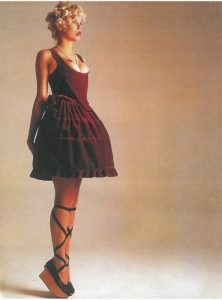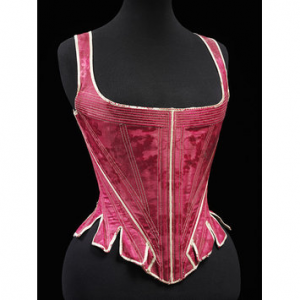
Photo taken from the book: Krell, G (1997). Vivienne Westwood (Fashion Memoir). unknown: Thames & Hudson.
Firstly, I looked within the university library at the section for famous fashion designers and found many books about Vivienne Westwood’s life and collections where she pushed the boundaries of the fashion world and incorporated unusual and shocking aspects within her work. I found this photo from her Harris Tweed collection which features a red velvet corset and mini-crini with her famous rocking horse shoes. It was within this collection that Westwood revived the corset and other 19th century garments as perhaps a symbol of sexual empowerment to prove that the corset is no longer seen as the symbol of women’s oppression.
This then drew me to look into the history of corsets where I found a similar one featured in Vivienne Westwood’s collection. The photo features a ‘Stay’ which is a corset style undergarment with straps which was most popular within the late 1700’s and were worn to accentuate the waist and shape the petticoat of the gown to the proper silhouette. Within the description of the garment there’s a quote from a letter written by the Duchess of Devonshire in 1778 where she complains that a similar corset to this one cut into her body and upper arms, ‘But it is the ‘ton’ [fashion]; and pride feels no pain.’ Which further cements the idea that corsets aren’t worth the pain if the 20th century doesn’t demand them.
I later found an article linked to this image on the V&A website discussing the reappearance and disappearance of the corset throughout the years and why designers would want to bring the corset back when its physically oppressive and associates with women’s inferior status. It discusses how originally Proiret banned the corset in 1909 as a statement and replaced the fashion with the focus on the shoulders which later evolved into the bi-dimensional dresses associated with the 1920s.
It then later came back into fashion in the 1930’s when the waist was rediscovered as the focal point of dresses after popular movies such as ‘Gone with the Wind’ and ‘Little Woman’ made Victorian style dresses popular again which featured small waistlines only achievable by wearing a corset underneath.
Since then many designers have tried to recreate the slim and smooth waistline that the corset creates with padding, boning and different cuts. The most famous being the ‘Bar’ suit designed by Dior which closely resembles the exaggerated hourglass silhouette of a corset.
It was only in the late 1970’s did Vivienne Westwood release the Harris Tweed collection revolutionizing the corset again which spurred other designers to do so, such as Jean-Paul Gaultier and Thierry Mugler where they exaggerated the garment and made it into some sort of futuristic armor. Since then the corset has never comeback fully as the pain and rigidness discourages the general public from accepting this historic garment back into today’s fashion.
Bibliography:
Unknown. (unknown). Stays. Available: http://collections.vam.ac.uk/item/O13864/stays-unknown/. Last accessed 26th Oct 2017.
Georgiana Cavendish, Duchess of Devonshire (1778). The Sylph. 2nd ed. unknown: T. Lowndes.
Unknown. (unknown). The Corset in Late 20th-Century Fashion.Available: http://www.vam.ac.uk/content/articles/t/the-corset-in-late-20th-century-fashion/. Last accessed 27th Oct 2017.
Krell, G (1997). Vivienne Westwood (Fashion Memoir). unknown: Thames & Hudson.

